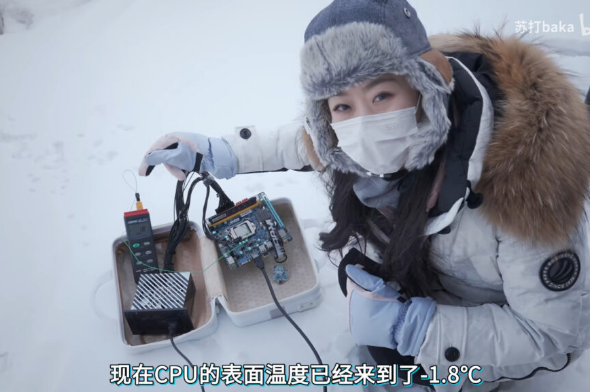Connection to DriversCloud Create a DriversCloud.com account Reset your DriversCloud.com password Account migration
A Chinese influencer puts her configuration to the test: the PC by -53°C!
What could be better than a good little ice age to keep our most demanding components cool?
Rather than using liquid nitrogen, Chinese influencer Baka probably thought that the easiest way to lower the operating temperature of her PC was to go tease the harshness of winter in Manchuria. One of the coldest regions of China was indeed going through a particularly icy period during the last two weeks. So Baka decided to take his small stuff, to bring his cameraman and, especially, his PC. Direction Mohe in the extreme north-west of Manchuria, one of the coldest cities in China, except for the Himalayas.
Like the big companies of the IT world who place their data centers in naturally cold countries, Baka tried the "outdoor PC" experiment when the temperatures were far below zero. The problem is that while the machine itself lived through the experience rather well, the cooling system that Baka initially used did not enjoy this frigid episode very much. It must be said that his PC was equipped with an AiO watercooling kit. Of course, the liquid inside the AiO didn't take long to freeze and the pump itself first turned slower and slower, before stopping completely, blocked by the icy liquid.
In order to replace it and allow the Intel core i9-13900K and NVIDIA GeForce RTX 4090 based configuration to start up, Baka used a strange aircooling system. There is nothing to say about the heatsink, which is a classic Noctua NH-P1. However, without really knowing why - apart from making pretty pictures - they used a real wall of small fans stuck together. That said, the solution in question had the sole purpose of refreshing the PC at startup. Then indeed, the -53°C of Mohe did the necessary.
We could even say that the conditions did more than what was necessary in reality. Indeed, the Core i9-13900K was capped at 3°C despite the 5.8 GHz boost mode which - in normal conditions - pushes the CPU to more than 90°C. Baka then had fun overclocking its CPU which was able to reach 6.18 GHz on all cores without any difficulty. The result of the graphics card is not worse with a GPU at -40°C during the calmest phases and at only 30°C in the worst case! To watch the video of the experiment performed by Baka, we invite you to click on this link.








